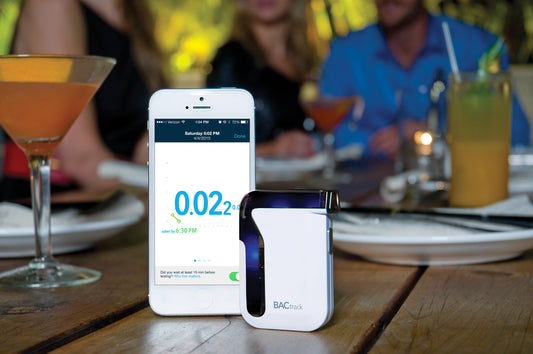The Science Behind the SingleShot
The Science Behind the SingleShot
The BACtrack Single Shot is a fast, convenient and easy way to detect the presence of alcohol in an individual’s breath. With no more than a pinch, users can determine with over 99% certainly whether or not they are at or over a certain BAC threshold. This is indicated by the changing color of crystals inside the device.
But what exactly is going on inside these terrific tubes? What are these nebulous “crystals” and why are they changing colors at certain BAC levels?
A Wonder in a Bottle
Inside each of the BACtrack SingleShots is a solution made of three substances: synthetic amorphous silica (SiO2 x H2O), sulfuric acid (H2SO4), and potassium dichromate (K2Cr2O7). The crystals themselves are almost completely composed of the silica (98.4% or greater),a colorless compound derived from sandstone.
The sulfuric acid and potassium dichromate compose less than 2% of the SingleShot solution, but are wholly responsible for the chemical reaction that transpires. These two compounds coat the silica and react with the alcohol in your breath to cause the change in color.
Science In Practice
The process of using the BACtrack SingleShot is simple. Wait 15 minutes after taking your last drink to ensure that the alcohol has cleared the mouth and throat so that it won’t interfere with the results. Squeeze the middle of the detector using thumb and forefinger in order to break the inner glass tube. The SingleShot solution is sealed in this tube in order for the chemicals to stay unadulterated by other vapors before use.
The user then breathes into the tube, and the chemical reaction begins. Sulfuric acid inside the SingleShot removes the ethyl alcohol from the breath, forming a liquid solution. This solution then reacts with the potassium dichromate to produce chromium sulfate potassium sulfate acetic acid water.
In order to help catalyze the reaction, the user then shakes the SingleShot and lays it on a horizontal surface for two minutes. During this time, if the alcohol level in the breath is high enough, the normally tawny yellow dichromate ions change color to blueish green chromium ions.
SingleShots come in three BAC threshold variations: 0.02%, 0.05%, and 0.08%. The BAC level that each is calibrated to detect is determined by the balance of sulfuric acid and potassium dichromate in the tube. Because of the science behind the reaction is known, you can be 99% sure of the results.
A Blast from the Past
The chromatic system of determining BAC is actually one of the oldest in the history of breath alcohol detection. The earliest of breathalyzers used the same chemicals in the BACtrack SingleShot, but instead of having a human judge the color change, they used machines.
In these crude devices, after the breath sample was taken, a monochromatic light beam passed through the colored crystals. The change in color intensity would be recorded. Based on the difference in colors, the percent alcohol in the breath could be roughly calculated.
The March of Progress
While the BACtrack SingleShot is good and convenient for rapid results, the devices are not without their drawbacks. One issue is that they are non-specific in their readings. That is, they identify not only the ethyl alcohol found in alcoholic beverages but also other substances similar in molecular structure, such as gasoline vapors or strong perfume. SingleShots also lose efficacy in one year’s time.
The very technology of detecting color change can also be challenging, especially if one is acutely intoxicated. For this reason, we advise SingleShot users to ask another, preferably sober individual, to help conduct the test and determine the outcome.
While the BACtrack SingleShot remains a convenient and quick reference device, breathalyzer technology has come a long way. The Xtend® Fuel Cell Sensors inside BACtrack Professional Breathalyzers are state-of-the-art. It is for this reason that these BACtracks have become a mainstay for doctors, clinicians, law enforcement officers, and concerned individuals around the world.




